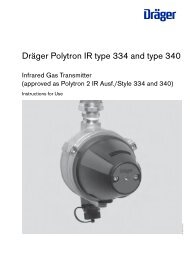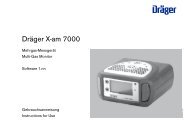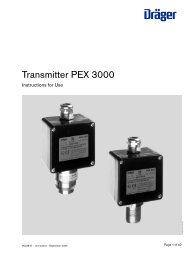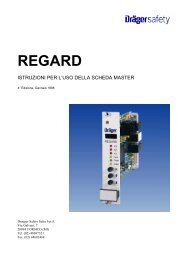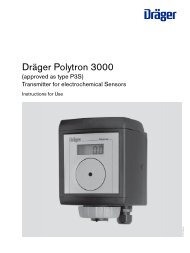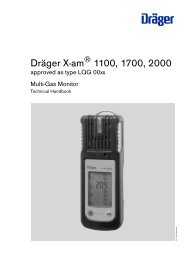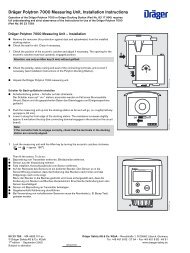Dräger X-am 1100 / 1700 / 2000 - ancb.it
Dräger X-am 1100 / 1700 / 2000 - ancb.it
Dräger X-am 1100 / 1700 / 2000 - ancb.it
You also want an ePaper? Increase the reach of your titles
YUMPU automatically turns print PDFs into web optimized ePapers that Google loves.
Close the vent of the test gas cylinder.<br />
• Take the instrument out of the calibration cradle.<br />
– When the reading is below the A1 lim<strong>it</strong>s:<br />
•<br />
press the [OK] key to acknowledge the alarms.<br />
The instrument is back in measurement mode and ready<br />
for use.<br />
I f the instrument does display the applied gas concentration<br />
w<strong>it</strong>hin the mentioned tolerance range:<br />
calibration by trained personell is required.<br />
•<br />
Carrying out the fresh air calibration<br />
Calibrate the instrument to fresh air, free of the presence<br />
of measured gases or other interfering gases. During the<br />
fresh air calibration the zero point of all sensors (w<strong>it</strong>h the<br />
exception of <strong>Dräger</strong>Sensor XXS O 2 ) is set to 0. The display<br />
of <strong>Dräger</strong>Sensor XXS O 2 is set to 20.9 vol.%.<br />
Sw<strong>it</strong>ch on the instrument.<br />
Press the [ + ] key three times, the symbol for fresh air<br />
• calibration » « appears. If the symbol is not displayed,<br />
press the [ + ] key again until the symbol appears.<br />
– The current gas concentration values flash.<br />
•<br />
Press the [OK] key in order to start the fresh air calibration.<br />
When the calibration is complete:<br />
– The current gas concentration display changes to the<br />
display » OK «.<br />
Press the [OK] key in order to acknowledge the calibration.<br />
•<br />
If an error has occurred during the fresh air calibration.<br />
– The error message » « appears and » « is<br />
displayed for the sensor concerned instead of the measured<br />
value. In this case, repeat the fresh air calibration.<br />
If necessary, the sensor should be replaced by qualified<br />
personnel.<br />
Maintenance<br />
The device does not need any special maintenance.<br />
Dirt and depos<strong>it</strong>s can be removed from the device by<br />
• washing <strong>it</strong> w<strong>it</strong>h cold water. A sponge can be used for<br />
wiping if necessary.<br />
ATTENTION:<br />
Abrasive cleaning implements (brushes etc.),<br />
cleaning agents and cleaning solvents can destroy<br />
the dust and water filter.<br />
Carefully dab dry the device using a cloth.<br />
•<br />
Servicing<br />
According to EN 50073, the instrument must be serviced<br />
and/or adjusted by qualified personnel at regular intervals.<br />
Disposing of the Device<br />
EU-wide regulations on the disposal of electrical and<br />
electronic devices as defined in the EU directive<br />
2002/96/EL and national laws pertaining to this<br />
device were adopted in August 2005.<br />
Special collection and recycling possibil<strong>it</strong>ies will be<br />
provided for private households. Since this device is not<br />
registered for use in private households, <strong>it</strong> must not be<br />
disposed of w<strong>it</strong>h private household waste. The device can<br />
be returned for disposal to your national <strong>Dräger</strong> Safety<br />
sales organization, which will be pleased to answer any<br />
questions you may have relating to disposal.<br />
Extract: see the Instructions for Use of the used<br />
sensors 1) for details.<br />
Ex O 2 H 2 S CO<br />
Reaction time t 0...50 ≤8 seconds ≤6 seconds ≤6 seconds ≤6 seconds<br />
Measuring accuracy [% of the measured<br />
≤5 ≤1 ≤2 ≤2<br />
value]<br />
Temperature influence<br />
– Zero point 0.1%LEL/K ≤±0.2 vol. % no effect ≤ ±5 ppm<br />
Long-time drift<br />
– Zero point ≤ ±3%LEL/month ≤ ±5 vol. %/year ≤ ±1 ppm/year ≤ ±2 ppm/year<br />
Effect of sensor poisons<br />
– Hydrogen sulphide H 2 S, 10 ppm<br />
Halogenated hydrocarbons, heavy metals,<br />
gases containing silicone, sulphur or<br />
polymerizable substances<br />
≤10% of measured<br />
value/8 hours<br />
Poisoning possible<br />
Technical data<br />
Extract:<br />
see the Technical Handbook 1) for details.<br />
Ambient cond<strong>it</strong>ions:<br />
During operation –20 to 50 o C<br />
and storage 700 to 1300 hPa<br />
10 to 95% relative humid<strong>it</strong>y<br />
Ingress protection IP 67 for device w<strong>it</strong>h sensors<br />
Alarm volume Typically 90 dB (A) in 30 cm distance<br />
Operation time<br />
– Alkaline battery Typically 12 hours under normal<br />
cond<strong>it</strong>ions<br />
– NiMHy<br />
rechargeable<br />
batteries<br />
– – –<br />
– – –<br />
Typically 12 hours under normal<br />
cond<strong>it</strong>ions<br />
Dimensions approx. 130 x 48 x 44 mm (H x W x D)<br />
Weight<br />
approx. 220 to 250 g<br />
CE marking:<br />
Electromagnetic compatibil<strong>it</strong>y<br />
(Directive 89/336/EEC)<br />
Low Voltage Directive<br />
(Directive 72/23/EEC)<br />
Explosion protection<br />
(Directive 94/9/EEC)<br />
Approvals: (see “Notes on Approval” on page 90)<br />
– – –<br />
– – –<br />
– – –<br />
– – –<br />
____________<br />
1) The Technical Handbook and Instructions for Use of the used sensors<br />
are included on CD.<br />
9



